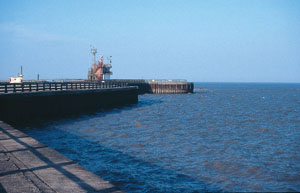 |
Gorleston is situated on the opposite side of the river Yar, directly south of Great
This pier and the one to the north form the entrance to the river Yar from the sea, and fishing is possible on both the inside and outside of the structure, meaning that you can fish the river as well as the open sea.
Gorleston is easy to access and there is ample parking beside the pier. This venue is suitable for disabled anglers and there is wheelchair access to all areas on the pier.
To find Gorleston, there are several options depending on which direction you are heading from. But the A12 or the A47 will take you near enough that Gorleston will be clearly signposted. Once in the town, follow signs to the seafront where you will find the pier.
1 The Old Lighthouse
Just off the riverside road there is a cracking little spot directly opposite an old lighthouse. This is probably the only spot on the river that can be fished when the water is tramping through. This is because the tide is so fierce that anchoring a bait could prove troublesome. This spot offers a little area set in a bend in the river, just before it heads straight out to sea. Here water is more subdued and settled, and gripping bottom is quite easy.
Feed tends to gather here attracting the fish and a simple lob of no more than 30 yards will put your bait right among them. Watch for the prominent tide rip, which will indicate the calmer water for casting into. Expect flounders, eels and dabs most of the time in summer and codling and whiting in the winter.
2 The River
From the car park by the pier, go left to the river. Here you will see a fence and the area to fish is from the fence up to the first set of steps that lead into the river. Forget your grip leads and notions of standard sea fishing, all you need here in the summer is a long rod, a 1oz or 2oz plain sinker, some hooks and frozen or live sandeels for bait, because it is large bass that you will be targeting. What you do is set up the lead on a running leger. Simply flick it out a few metres uptide. Secure the rod so that it protrudes a few feet out from the wall and allow the sinker to flow downtide, where it will hover about mid-water where large bass are often feeding. Remember to loosen the drag on your reel so that a lunker does not drag your gear into the river!
3 Pier Head East
This spot on the pier is more of a winter venue and in rough weather can test the hardiest of anglers. The best time to fish this area is when the tides are not too big or when the water is slacker. There is plenty of room for several anglers, which always makes for a more comfortable session. Here you are fishing directly east into the open sea and into some deep water. Use big worm baits cast 50 to 70 yards to locate the fish that feed in the tide rip. Expect codling, whiting and the occasional decent sized cod. Because there is no need for distance, maximise your chances of success by using three-hook rigs. In the summer months expect flounders, dabs and the chance of a bass.
4 Pier Head South
Dig out your most powerful rod when fishing this spot, because from here you should cast southwards as far as you possibly can. Also, a strong rod will help you haul a good fish up. It’s best to use single snood, clipped-down rigs to help maximise your distance. Use worm baits to target codling, whiting and dabs in the winter. In the summer, a variety of the regular species is the usual catch. Try fishing down the wall for eels and possibly large flounders using rigs with attractors and hooks baited up with ragworms. Do not be tempted to fish the little bay formed by the pier walls, as it is shallow, snaggy and generally unproductive.
5 Wooden Rails
This area is on the south side of the pier and during the winter and summer can produce a multitude of different species. It is possible to catch fish here at any range. During the spring, large flounders can be winkled out from right at the base of the wall. Just like the rest of the pier, worm baits seem to be the most productive at any given time of year. This is possibly the most popular spot along the pier as there is plenty of room for many anglers, and the wooden railings have loads of grooves in them that have been cut out by anglers over the years to acts as rod rests. What’s more, there are plenty of wooden seats around that are suitable for the more relaxed anglers.
6 The Shelters
On the most southerly part of the pier is a row of shelters that allow for comfortable fishing during the colder months, as well as providing shade during the summer. This particular spot fishes best at extreme range, or at least as far as you can possibly cast. This will put your baits in among the fish, which are likely to be codling, flatties and whiting in the winter and the usual summer species with the chance of a decent bass. Fishing close in or even straight down the wall will not be quite as productive, but there is always a chance of a few good fish. However, it is always worthwhile setting a few crab lines, because if the fish refuse to make a show, then at least you could have an edible crab or three for the pot!
Tackle Shops
Greenstead Tackle Centre 73 High Street, Gorleston, Great Yarmouth. Tel: 01493 602474
Gorleston Tackle Centre Ltd 7-8 Pier Walk, Gorleston, Great Yarmouth. Tel: 01493 662448
TSF Top Tip 1
Using a clipped-down, single hook rig will help you to achieve maximum casting distance at marks 4 and 6.
TSF Top Tip 2
Try a mackerel head and guts fished down the side of the pier wall for the chance of a monster bass.





